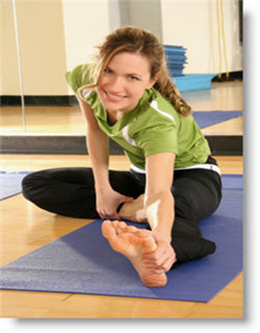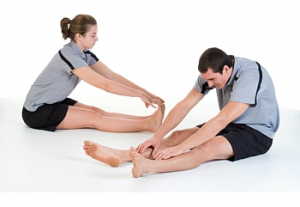How to Stretch, When to Stretch and Stretching Properly
Answers to common stretching questions to make sure you’re stretching properly.
by Brad Walker | First Published August 27, 2010 | Updated May 29, 2017
Stretching properly is a little more technical than just swinging your leg over a park bench. There are methods and techniques that will maximize the benefits and minimize the risk of injury. In this article we’ll look at some of the most common questions people ask about how to stretch properly. Questions like: Which muscles should I stretch? When should I stretch? Should I stretch every day? Plus a whole lot more.
Which Muscles Should I Stretch?
As a general rule; if it’s not tight and it’s not causing you any problems, you don’t need to stretch it. There are a few exceptions to this (such as athletes that require increased flexibility for their chosen sport), but for most people this is a wise rule to follow. So if you perform a stretch and you don’t feel any tension in the target muscle group, this would indicate that you’re not tight in that area.
As you start to notice which muscles are tight and which muscles aren’t, aim to create a balance of flexibility between the front and the back of your body, and the left side body and the right side of your body. For example, if you notice that your right hamstring muscles are tighter than your left hamstrings muscles, work on the right hamstring muscles until you have even flexibility in both.
When to Stretch?
Most people understand the importance of stretching as part of a warm-up or cool-down, but when else should you stretch?
Stretch periodically throughout the entire day. It is a great way to stay loose and to help ease the stress of everyday life. One of the most productive ways to utilize time is to stretch while watching television. Start with five minutes of marching or jogging on the spot then take a seat on the floor in front of the television and start stretching.
Should I Stretch Every Day?
Firstly, we need to make a distinction between doing a few gentle stretches and doing a more intense flexibility training session. Doing a few gentle stretches every day is fine. In fact, I encourage all my clients to take regular “Stretch Breaks” throughout the day to keep loose and limber. However, a more intense flexibility training session is another thing altogether.
I like to approach flexibility training the same way as one approaches strength training. When an athlete does strength training, they typically focus on one or two movement patterns that compliment their sport. And this is the same approach I take with flexibility training. The client will focus on one or two movement patterns at a time, and work on the flexibility of the muscle groups involved in those movement patterns.
For example, an athlete involved in a kicking sport like Australian Rules football or soccer would focus on the muscle groups associated with kicking: The hamstrings, buttocks and lower back.
Variety of Stretches
Including a variety of stretching exercises in your training program is very important for avoiding muscle imbalances. While an athlete may go to the gym every day, no intelligent athlete would do the same set of exercises every day, day after day. The same approach applies to flexibility training; while it is okay to do flexibility training every day; it’s not a good idea to do the same stretches every day, day after day.
What Type of Stretching?
Choosing the right type of stretching for the right purpose will make a big difference to the effectiveness of any flexibility training program.
For warming up, dynamic stretching is the most effective, while for cooling down, static, passive and PNF stretching are best. For improving range of motion, try PNF and Active Isolated stretching, and for injury rehabilitation, a combination of PNF, Isometric and Active stretching will give the best results.
For an in-depth definition of the different types of stretching, the advantages and disadvantages of each type, plus a detailed explanation of how to perform each type, grab a copy of the Ultimate Guide to Stretching & Flexibility.
Hold, Count, Repeat
For Static and Passive stretching, some text will say that holding a stretch for as little as 10 seconds is enough. This is a bare minimum. 10 seconds is only just enough time for the muscles to relax and start to lengthen. For any real improvement to flexibility, each stretch should be held for at least 30 to 60 seconds, and repeated at least two or three times.
Order of Stretches
Limited data exists on what order individual stretches should be done in. However, some researchers have suggested designing flexibility training programs that start with the core muscles of the stomach, sides, back and neck, and then work out to the extremities.
Others have recommended starting with sitting stretches, because there is less chance of accidental injury while sitting, before moving on to standing stretches.
The exact order in which individual stretches are done is not the main point of emphasis; the main priority is to cover all the major muscle groups and their opposing muscles, and to work on those areas that are most tight or more important for your specific sport.
Stretching Posture
Poor posture and incorrect alignment can cause imbalances in the muscles that can lead to injury. While proper posture will ensure that the targeted muscle group receives the best possible stretch.
In many instances one major muscle group can be made up of a number of different muscles. If posture is poor or incorrect certain stretching exercises may put more emphasis on one particular muscle within that muscle group, thus causing an imbalance that could lead to injury.
The picture below, for example, shows the difference between good posture and poor posture when stretching the hamstring muscles (the muscles at the back of the upper legs).
During this stretch it is important to keep both feet pointing straight up. Allowing the feet to fall to one side will put more emphasis on one particular part of the hamstrings, which could result in a muscle imbalance.
Note the athlete on the left; feet upright and back relatively straight. The athlete on the right is at a greater risk of developing a muscular imbalance that may lead to injury.


